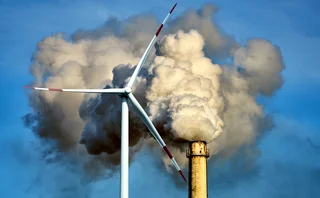Video Q&A: GFI’s Michael Cosgrove on carbon markets

Q. Do you foresee federal legislation for carbon markets this year?
A. Michael Cosgrove: I think the odds of a federal cap-and-trade system this year are virtually nil and I think next year the odds are quite long also. There has been a change in public sentiment, particularly in the past year, but really over the past three years, and I think that is taking quite a lot of the pressure off politicians to actually do something about climate change in North America.
Q. How do you see the development of a national scheme feeding into a global carbon emissions trading system?
A. Clearly the best result that we could have for a cap-and-trade programme or for any kind of carbon mitigation programme would be one where the US is part of a global programme. I think that currently it will be very challenging to enact legislation to create such a programme.
The one thing that may be creating some pressure to do so, however, was the recent announcement by the US Environmental Protection Agency (EPA) that they have deemed CO2 to be a gas that they can essentially enact programmes to mitigate. Clearly no-one wants the EPA to run a national carbon programme and so the terror that that announcement inspired does actually create some motion that otherwise wouldn’t be present, pending legislation in this area.
Q. In the meantime, what future do you see for the development of the regional schemes in the US?
A. Well, the RGGI (Regional Greenhouse Gas Initiative) just had a very large auction [on March 10, 2010 of 40,612,408 allowances] and those allowances are trading at about $2.13 per ton, which is just over the floor of $1.86/ton. I think it’s quite encouraging that a large amount of allowances were soaked up and the price wasn’t immediately offered at the floor [of $1.86/ton].
There are a couple of other initiatives, for example the Chicago Climate Exchange, which Dr Richard Sandor started [in 2000]. There’s also the Climate Action Reserve (CAR) standard for carbon allowances, as well as the Western Climate Initiative and the Mid-West Climate Initiative.
At present, it seems the gold standard for carbon credits in North America is CAR credits. Last year they were changing hands at around $7.50/ton and I think they were being originated at between $5/ton and $6/ton. They seem to be valued at around $5/ton now but compared to all of the other schemes, they are by far and away the most richly priced credits – and I think that reflects the expectation that in the event of a federal programme, the CAR protocol is most likely to be adopted.
Q. So until a federal scheme is put in place, will all of the regional schemes work to that protocol?
A. They’re all working to slightly different standards. I think that it will be interesting to see how these develop. At this stage, it’s very hard to determine how these regional programmes could become more fungible and in fact work together. I think it’s too soon to really have a good sense of that.
Q. How would you characterise the current mood among US emissions market players?
A. I think the momentum is fairly poor right now for climate legislation. Clearly the healthcare debate has consumed an enormous amount of energy and time and political capital and it’s still unresolved. After the resolution of the healthcare debate one way or another, it seems most likely to me that the next important consideration will be financial reform. It will leave very little time and energy for climate legislation.
Q. How would that feed into trading activity? Will it have an effect?
A. Yes, I think it will. But it is interesting – in spite of all the terrible news, that there is still quite a lot of interest on the part of large commercial and industrial concerns to, at a minimum, gain expertise in dealing with carbon offset markets. We’re finding that there is still buying interest for greenhouse gas offsets in North America.
More on Carbon
Uncertainty causes rethink on clean energy investment
Waning enthusiasm for net-zero pledges, environmental policy shifts, funding cuts and US tariffs are causing clean energy investors to retreat
Emissions house of the year: Grey Epoch
Energy Risk Awards 2025: Carbon trader meets clients’ increasing needs through deep expertise and ability to warehouse risk
Environmental products house of the year: Marex
Energy Risk Awards 2025: Marex Environmental spans firm to give all clients access to green markets
Market-maker/liquidity provider of the year: OTC Flow
Energy Risk Awards 2025: Environmental trader and broker furthers liquidity provision with new presence on exchange
Commodity trade finance house of the year: Tramontana
Energy Risk Awards 2025: Investment firm creates unique carbon trade finance vehicles enabling long-term hedging while developing carbon market liquidity
Voluntary carbon markets house of the year: SCB Environmental Markets
Energy Risk Awards 2025: Environmental specialist amplifies its commitment to the VCM
Green knights? Banks step into struggling carbon credit markets
Clearer global standards and a new exchange may attract dealer entry, but supply and demand challenges remain
Achieving net zero with carbon offsets: best practices and what to avoid
A survey by Risk.net and ION Commodities found that firms are wary of using carbon offsets in their net-zero strategies. While this is understandable, given the reputational risk of many offset projects, it is likely to be extremely difficult and more…







